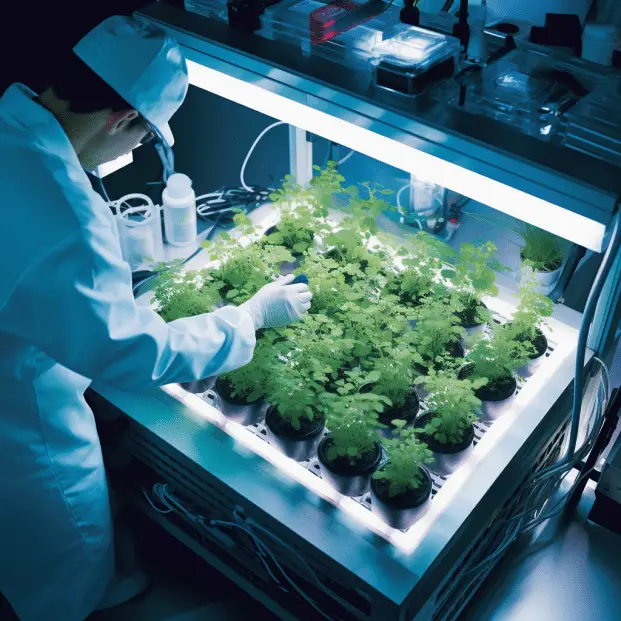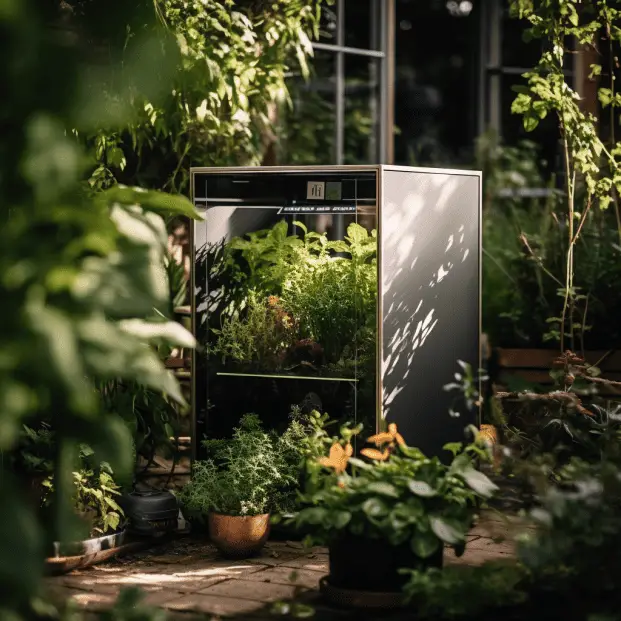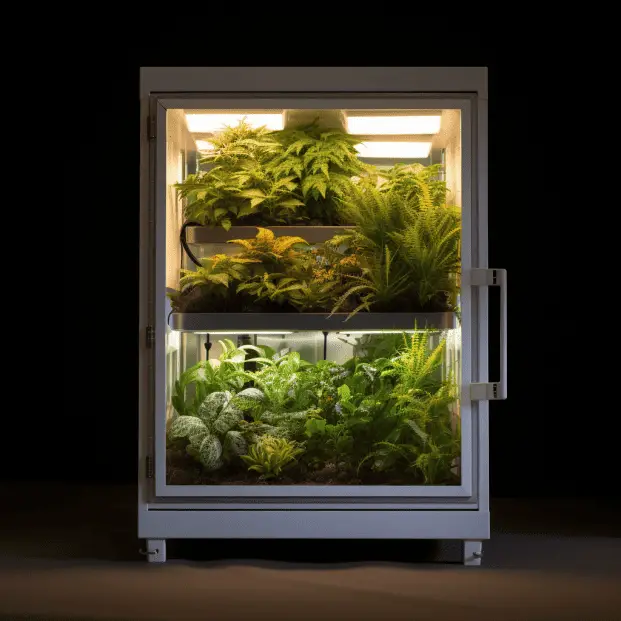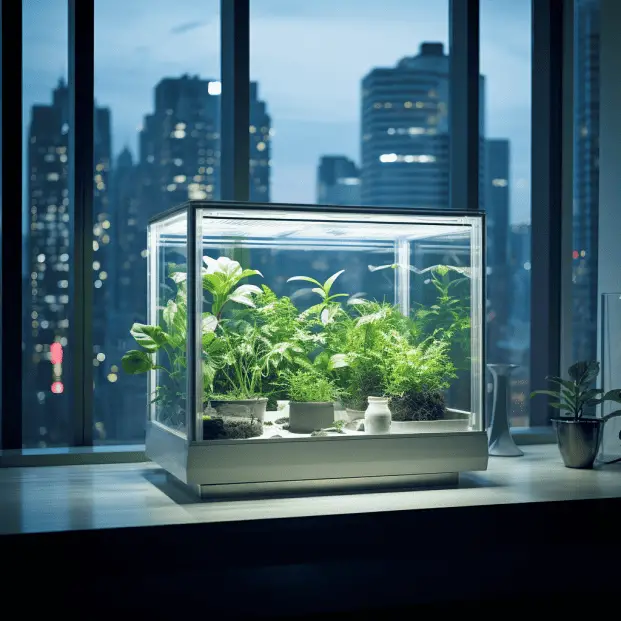Tired of lackluster produce from the grocery store? Craving fresh herbs and veggies straight from the garden? An indoor grow box may be the solution you need!
I used to think grow boxes were complicated contraptions reserved for hardcore gardeners.
But after seeing my neighbor’s bountiful basil and pepper harvests from a simple DIY setup, I was hooked.
Now my tiny apartment overflows with homegrown tomatoes and lettuce.
Grow boxes come in many shapes and sizes to fit your space and plants.
From converting an old cabinet to purchasing a specialized hydroponic unit, the options are endless.
In this guide, I’ll walk through beginner-friendly grow box basics.
You’ll learn how to choose the best system and transform even limited space into a thriving indoor edible garden.
Let’s dig in – your fresh salad greens await! Just be warned: once you start reaping homegrown produce from a grow box, you may get a bit addicted.
I know I did!
KEY TAKEAWAY
What is a grow box?
A grow box is a versatile, self-contained gardening system that allows you to cultivate plants indoors or outdoors, providing controlled conditions for optimal growth and convenience. (1)
Understanding the Basics of a Grow Box as Complete Systems
Also called grow cabinets, grow tents or indoor gardens, grow boxes offer a simple way to cultivate plants indoors.
A grow box creates an ideal controlled environment for your plants to thrive.
Grow boxes provide benefits like:
- Precise lighting, temperature and humidity for growth
- Protection from pests and diseases
- Ability to grow all year long regardless of weather
- Higher yields in smaller spaces
They come in many sizes, from small stealth cabinets to tent-style boxes accommodating numerous plants.
Grow boxes make indoor gardening accessible for everyone from beginners to experienced green thumbs!
How Grow Boxes Function and Their Components

A grow box consists of an enclosed, light-proof structure for housing plants, along with equipment to provide everything plants need:
- Lighting – Special grow lights (fluorescent, LED, HID) optimized for plant growth
- Air Circulation – Fans and ventilation keep air moving and prevent mold
- Growing Medium – Soil, coco coir, perlite etc to support roots
- Irrigation – Drip systems or hand-watering to deliver water and nutrients
- Humidity Control – Exhaust fan, dehumidifier, humidifier regulate moisture
- Temperature Control – AC units, heaters, circulation fans maintain optimal temps
Quality grow boxes integrate these components into an all-in-one system for controlling the environment.
High-end boxes can fully automate temperature, humidity, lighting and more to optimize conditions.
Active vs. Passive Grow Boxes: Which is Better?

Passive grow boxes rely on natural airflow and lack equipment beyond basics like lights and fans.
Passive boxes are more affordable and simpler to operate.
Active boxes integrate full environmental controls.
Active systems automatically maintain perfect conditions for growth with timers, thermostats, humidistats and other tech. (2)
This prevents issues and yields higher, but costs more upfront.
For beginners, passive grow boxes are a great starting point.
As your skills improve, invest in a high-quality active grow box system to maximize growth and free up your time.
The Role of Water and Fertilizers in Grow Boxes

Inside a grow box, plants need consistent water and nutrients.
Some methods for providing these essentials include:
- Soil – Amend with compost or fertilizers to fuel plants
- Hydroponics – Nutrient solution circulated to plant roots
- Drip System – Gradually feed plants on a schedule
- Automatic – Timers or floats automatically water as needed
- Hand-watering – Manually water based on plant needs
Adapt your watering and fertilizing approach to your grow box setup.
Soil with compost or slow-release fertilizer is simplest.
Hydroponics and drip systems automate feeding for convenience.
Or stick with good old hand-watering for full control.
Getting Acquainted with Different Types and Brands of Grow Boxes
Many brands now offer complete grow box systems. Here are some top options:
- Gorilla Grow Tent – Sturdy, reflective tents from 24″ to 10′ across. All-steel frame.
- Vivosun – Affordable grow kits with tent, lights, filters and more. Good for beginners.
- Yield Lab – Systems focused on energy efficiency and space savings. Unique triangle design.
- Kind LED Grow Light – High-end LED grow lights maximize yields. Full spectrum white lighting.
- Secret Jardin – Premium tents with excellent lightproofing and durable construction for maximum durability.
- Hydroponic Systems – Complete active hydro grow boxes with environmental controls dialed in.
Do your research to find the best grow box system for your needs and budget.
Quality construction and the right components make all the difference for the ideal environment.
Maximizing Yield with Grow Boxes: Tips and Techniques
To get the most out of your grow box, follow these tips:
- Select plants suited to indoor cultivation like herbs, lettuce, peppers, tomatoes etc. Start with easy beginner varieties.
- Use determinate, compact plant types that thrive in limited space. Avoid sprawling or vining plants.
- For hydroponic systems, use an active box with a reservoir and automated controls. This prevents fluctuations in conditions.
- Go LED grow lights for energy efficiency. Full spectrum LED grow lights last longer and run cooler than other types.
- Maintain stable, ideal temps between 70-80°F. Rapid temperature swings cause plant stress.
- Keep humidity around 60-70% during vegetative stage, lowering to 45-50% in flowering/fruiting.
- Ensure constant airflow and ventilation. Stagnant air encourages problems like powdery mildew.
With the right setup and practices, your plants will flourish in their controlled indoor sanctuary away from the elements.
The Advantages of Indoor Grow Cabinets
Why use an enclosed grow box rather than open shelving? Grow cabinets provide many benefits:
- Lightproof – Reflective lining ensures all light reaches plants, not surroundings.
- Odor Control – Exhaust fans vent smells. Carbon air filters absorb odors.
- Stable Conditions – Easy to perfect and automate temperature, humidity, etc year-round.
- Energy Efficient – Built-in insulation holds heat and humidity while saving power.
- Compact Design – Maximize plant yields even in tight spaces like apartments.
- Stealth Option – Lockable cabinets with discreet ventilation can prevent intrusions.
- Mobile – Rollers allow rearranging plants or moving them to follow light.
For managing the growing environment, enclosed grow boxes outperform open-air solutions.
The more dialed in your system, the more productive your plants.
Unlocking the Magic of Grow Boxes for Green Thumbs
I hope this guide has shown the incredible potential of grow boxes, whether you’re a newbie or seasoned expert.
With grow box gardening, you can cultivate edibles and ornamentals:
- In any climate, 365 days per year
- Without large plots of land or big investments
- With full control over growing conditions
- In discrete spaces like apartments or offices
- Automated for simplicity
- Optimized for productivity with vertical growing
Grow boxes let you flex your green thumb indoors and enjoy gardening year-round.
Implement the tips in this guide, and your grow box will churn out bountiful harvests to be proud of.
The possibilities are endless – now go get growing!
Frequently Asked Questions
What are the benefits of using a grow box?
Grow boxes offer many advantages for indoor gardening:
- Precise control over LED lighting, temperature, humidity
- Protection from pests, diseases, weather fluctuations
- Higher yields in limited space compared to outdoors
- Ability to grow year-round regardless of climate
- Automated systems require less maintenance
- Compact footprint fits in small living spaces
What size grow box do I need?
Choose a grow box size based on your available space and number of plants.
Box dimensions are measured by length x width x height. Common sizes:
- 2’x2’x4’ – Good for 1-2 small plants
- 3’x3’x6’ – Accommodates 2-4 medium plants
- 4’x4’x6’-7’ – Fits 4+ larger flowering plants
- 5’x5’x7’ – Ideal for 4-8 bigger plants like tomatoes
Scale up or down according to your needs. Bigger isn’t always better!
What plants grow best in grow boxes?
When you are trying to grow plants, focus on compact, fast-growing veggies and herbs:
- Lettuce, kale, herbs
- Peppers, tomatoes, green beans
- Strawberries, blueberries, raspberries
- Radishes, carrots, beets
- Dwarf or patio fruit trees
Avoid sprawling vines and huge root vegetables that need more space.
What grow lights work best?
LED grow lights and fluorescent lights are ideal for grow boxes.
Benefits of growing plants with them:
- Energy efficient and low heat
- Customizable color spectrum for plant stages
- Long lifespan of 50,000+ hours
- Compact size fits grow spaces
- Low operating costs
Use full spectrum or plant-specific LEDs for maximum yield.
How much will a grow box cost?
Basic passive systems start around $150.
High-end automated grow boxes with hydroponics can cost over $2,000.
Expect to invest $300-$800 for a quality beginner setup with tent, LED light, ventilation kit and other core components.
The more accessories, the higher the price tag.
Are grow boxes difficult to use?
Quality grow boxes are designed for simplicity! Beginner-friendly boxes have basic lighting and climate controls.
For set-and-forget ease, upgrade to an automated smart grow box that dials in perfect conditions.
Start simple and add tech as desired.
With the right grow box, even novice indoor gardeners can cultivate a lush plant utopia inside their homes.
Give it a try and unlock your green thumb potential today!
Conclusion
Before you leave…
Now you’re ready to build your own indoor bounty with a customized grow box setup!
Remember to choose an appropriately sized box and lighting system for your space and plants.
Use quality soil and nutrients to fuel plant growth.
And don’t forget ample drainage and airflow.
Did you know you can even grow vegetables and herbs hydroponically in grow boxes? I’ll cover easy DIY hydroponic grow box ideas in an upcoming guide.
Get ready to take your indoor gardening to the next level!
How To Create Your Own Hydroponic Grow Box for Fresh Produce All Year
Growing indoors with a customized grow box opens up a world of edible possibilities.
Continue nurturing your green thumb and enjoy the fruits (and veggies) of your labor!
References
- https://en.wikipedia.org/wiki/Grow_box
- https://www.epicgardening.com/grow-room-ventilation-101/
Related Articles
- https://tophydroponicgarden.com/grow-media/
- https://tophydroponicgarden.com/diy-hydroponic-kits/
- https://tophydroponicgarden.com/how-to-use-a-hydroponic-grow-box/
You May Like These…
Supercharge Your Grow Box Garden: Accelerating Plant Growth – Discover methods to achieve faster and more bountiful results in your grow box garden.
Effortless Indoor Gardening: Streamlining Your Grow Box Setup – Learn how to simplify the process of setting up and using your grow box for hassle-free gardening.
Optimizing Grow Box Performance: Achieving Lush, Healthy Plants – Unlock the secrets to obtaining better, healthier, and more productive plants with your grow box.
Expanding Your Grow Box Garden: Maximizing Yield – Explore strategies to maximize the number of plants and the yield from your indoor grow box garden.
Budget-Friendly Grow Box Gardening: Tips for Cost-Efficiency – Discover cost-effective techniques to enjoy the benefits of grow box gardening without breaking the bank.
Efficient Grow Box Care: Save Time and Effort – Save time and effort while maintaining your grow box garden with these time-efficient care techniques.
Common Grow Box Challenges and How to Overcome Them – Find solutions to common issues that can arise when using grow boxes for your indoor gardening.
Was this helpful?

Crystal Erickson is an agriculture enthusiast and writer with a passion for sustainable farming practices and community development. Growing up on a family farm in rural Iowa, Crystal developed a love for the land and a deep appreciation for the hard work and dedication required to make a farm successful.
After completing a degree in Agriculture and Environmental Science from Iowa State University, Crystal began her career as an agricultural journalist, covering stories and issues related to modern farming practices, crop management, and livestock production. She quickly established herself as a respected voice in the industry, known for her insightful reporting and thoughtful analysis.
Over the years, Crystal has written for a variety of publications, including Farm Journal, Successful Farming, and Modern Farmer, as well as contributing to several academic journals focused on sustainable agriculture and community development. Her work has been recognized with numerous awards, including the Iowa Farm Bureau’s Young Farmer Achievement Award and the National Association of Farm Broadcasting’s Farm Broadcaster of the Year.


